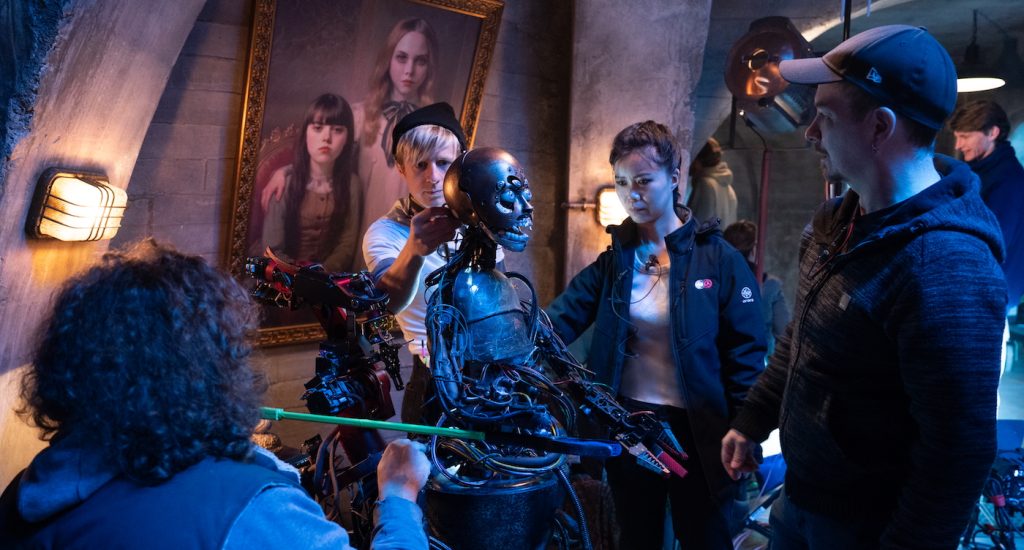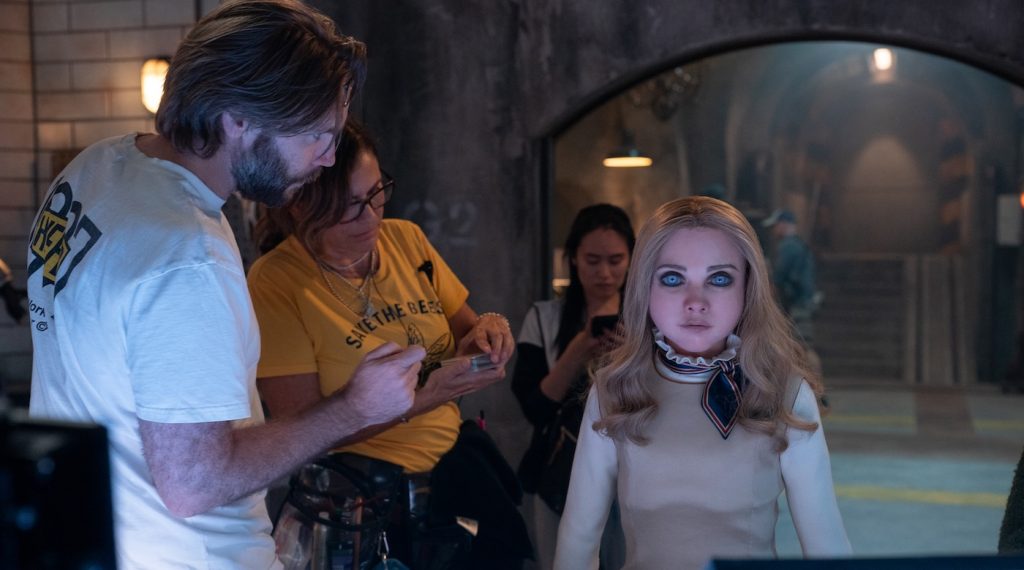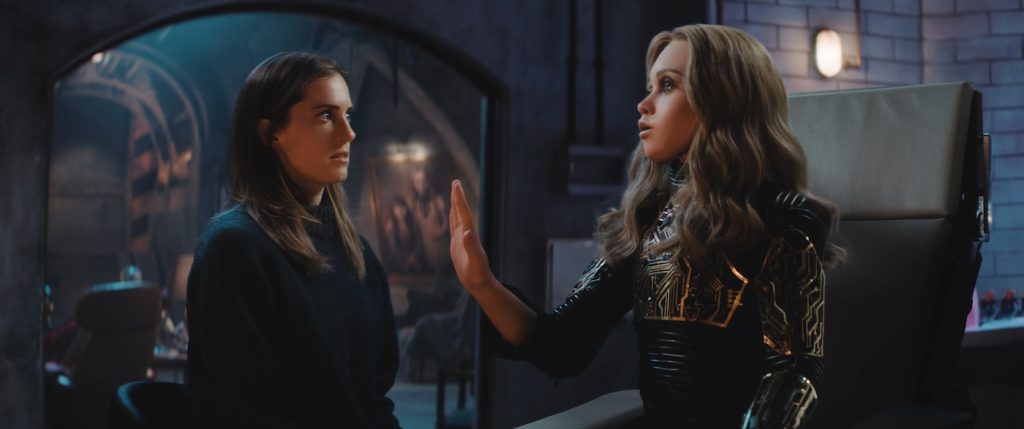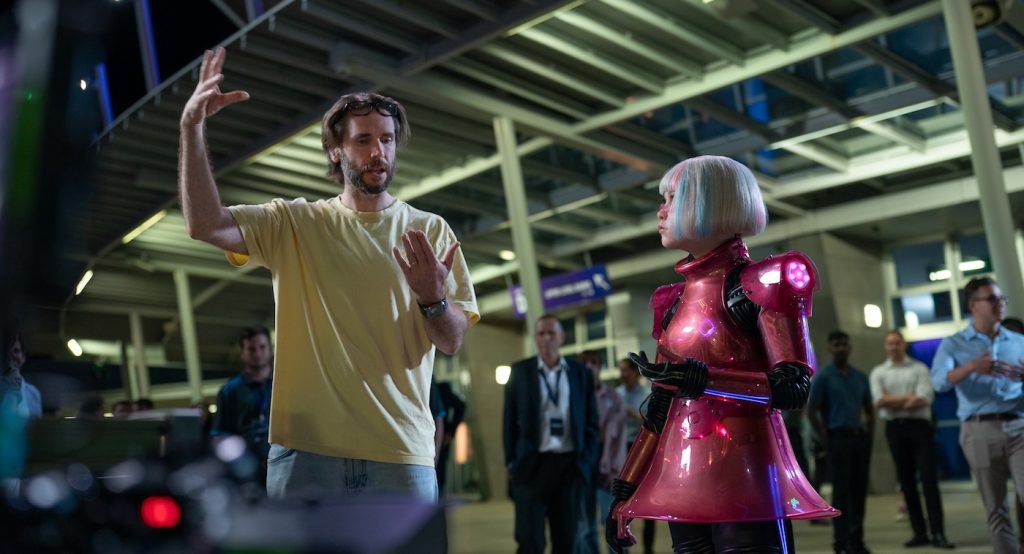The Secret Behind “M3GAN 2.0”: FX Duo Adrien Morot & Kathy Tse Reveal How They Perfected Horror’s Creepiest Eyes
Early in M3GAN 2.0 (in theaters now), the robotic title character complains to her maker Gemma (Allison Williams) about being confined to the clunky body of Teletubby simply because it/she killed a bunch of people in the first movie. Negotiating for an upgrade to fend off a weapons-grade android, M3gan says, “I want to be stronger. Faster. And while you’re at it, make me taller.”
That last demand posed a challenge to Morot FX Studio principals Adrien Morot and his wife, Kathy Tse. Child actor Amie Donald filmed the first M3GAN when she was 12 and grew several inches by the time production began on the sequel. Tse, a former banker, and the Montreal-born Morot, who earned an Oscar for sculpting Brendan Fraser’s photorealistic fat suit in The Whale, played catch-up from their southern California studio, while the ever-growing star wreaked on-screen havoc in New Zealand for director Gerard Johnstone.

Morot, speaking from Atlanta where he’s overseeing prosthetics for Nic Cage and Christian Bale’s Madden biopic, joined Tse from their Palo Alto home in suburban Los Angeles to break down the masks and puppetry behind the biggest-grossing psycho-doll in horror movie history.
Megan’s secret weapon, cinematically speaking, has to be her creepy eyes. How did you come up with that killer gaze?
Adrien: As a kid, I used to read Fangoria all the time, and for some reason, I had this fixation on doing fake heads. I especially liked this artist, Ed French, who worked on low-budget horror films like C.H.U.D. and Sleepaway Camp. The fake heads Ed made always had strikingly realistic eyes, so his work made me understand early on that if you can nail the eyes, that’s where your attention is immediately drawn. I’ve always been very aware of how the eyes open, the placement of the iris within the eye, and partly out of that, Kathy and I developed our expertise in making realistic dummies.


Certainly in the case of Megan, the eyes are compelling and yet not quite human. . .
Part of the secret when we went to work on M3GAN was that it was important to make the eyes a little bit like The Polar Express. Her eyes don’t seem to be looking at anything until she looks you straight in the eye, and that’s when you feel Megan’s gaze on you. It was important to nail that down in the first movie and improve on it in the sequel.
In both M3GAN movies, you would fit a silicone mask over the face of actress Amie Donald some of the time, and other times, you place the mask over an animatronic doll?
Adrien: The basic rule for both the first and second movies is that if it’s a close-up or medium shot, it’s our remote-controlled animatronic doll. When it’s a wider shot, like when Megan is running on all fours or doing the famous TikTok dance in the first movie, or when we see her fighting in the new film, then it’s Amie herself wearing one of the masks we’ve made.
Are you able to achieve everything you need through puppetry?
Adrien: The [animatronic] hands are beautifully articulated and the movements are very graceful, but they don’t have any strength, so if the doll needs to grab something heavy, then Kathy jumps in and she’s in the hands of Megan. It’s like a more sophisticated version of Elmo on Sesame Street. Kathy’s wearing a Megan glove through the sleeve, and then she manipulates the thing, with a monitor to tell her where to move.

Kathy, sometimes you ARE Megan’s evil hands!
Kathy: Well, Amie has grown to the point where we are close in size, and her hands are actually a smidgen bigger than mine. In the new movie, there’s a singing scene she does with Allison [Williams] that’s a combination of our animatronic robots and my hands and my arms. I think it works quite well. And then the scene at the lab where we see Megan pick up a gun, changing the bullets — again, that’s animatronic Megan with my hands, plus Adrien and his puppeteering team.

Child actress Amie Donald made the first M3GAN at the age of 12 and just kept growing. How did you accommodate her growth spurt?
Adrien: We had almost a year to prepare for M3GAN 2.0 from the first discussions until we went to camera. Amie grew almost like eight inches, so all the models and sculptures we did at the beginning of pre-production had to be redone when we realized how much taller she’d become.
Kathy: The bridge of Amie’s nose got bigger, her forehead — everything changed. The first time we tried the mask on her, she was squished inside like a little dumpling. Amie’s such a trooper; she never complained, not a peep, and then we realized her nose was completely pressed down!
Adrien: For M3GAN 2.0, Gerard, our director, wanted to edit seamlessly from animatronic Megan to Amie without anyone feeling the difference, so we rounded off the doll’s shoulders, made it a bit stronger in the torso, arms, and legs, always trying to catch up with Amie.

To make the prosthetic masks for M3GAN, first, you need body scans. Did you scan Amie in New Zealand, where the film was shot?
Adrien: That’s the magic of working digitally. Amie went to WETA in Wellington, New Zealand, and they scanned her there. Then they sent us the visual data, and we could work from that in California.
You’d feed the data to 3D printers that fabricated the masks, right?
Kathy: Yes, and then each mask has to be painted by hand, the hair has to be punched into a lace grid one strand at a time, the eyelashes, the eyebrows, all that stuff. But even before we got to that part of the process, we had to figure out the softness and thickness of the silicone. If we put a skin on an animatronic mechanism and could feel the paddles underneath, then we’d thicken the silicon, making it softer up here and harder down there. There was a lot of R&D before we got to the point of gluing the mask onto the mechanical face.
Adrien: The thing with M3GAN is that the movements have to fit her personality, and again, it comes back to the eyes. You’re never quite sure what she’s thinking. There’s an economy of movement there, and after working with Amie a few weeks in the first movie, we established this body language: Megan looks with her eyes first, and then the head moves [sideways]. If she says a series of sentences, at the end of the first sentence, she blinks. Then we have her blink again after the last group of sentences to punctuate the thing. And it can be a fast blink or a slower blink. All of that was carefully thought through.

The sequel pits Megan against a military-upgraded “Amelia” robot portrayed in the flesh by Ivanna Sakhno. How did you put that character together?
Adrien: We did 3D scans of Ivanna at her studio, took photo references of her hair, her eyes, her skin, and used all those samples to make a database to create our animatronic version of Amelia.
Kathy: We used animatronics for specific scenes, like after Amelia’s been kidnapped and covered in a bag. When they remove the bag and Amelia looks directly into the camera — that’s animatronic.
Adrien: Ivanna was amazing at playing this very still robot with the inner gaze. She blended really well with our puppet.
Adrien, you grew up in Montreal and moved to Los Angeles, thinking of Hollywood as the film and TV capital of the world. In recent years, film production in California has experienced a decline. Can you and Kathy talk about how it feels for you and your peers to experience this downturn in local filmmaking?
Adrien: How much time do we have? [laughing]. I think it’s a tragedy. As an immigrant to the U.S who grew up on movies and TV, the background canvas of everything I love is California-based. On top of that, filmmaking brings so much to the local economy. When you think about the creative powerhouse that happens when you have everybody in one place coming up with amazing content – when movies are being shot everywhere else, for me, it just feels like something gets lost when you start spreading yourself thin.
M3GAN 2.0 is in theaters now.
Featured image: M3GAN in M3GAN 2.0 directed by Gerard Johnstone.



